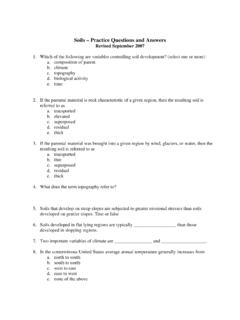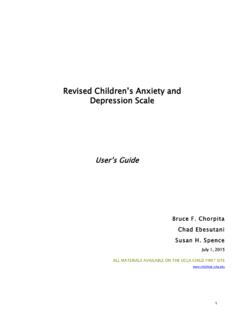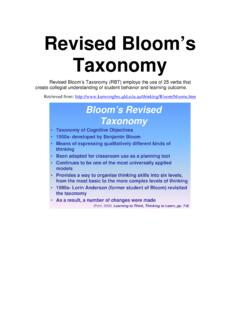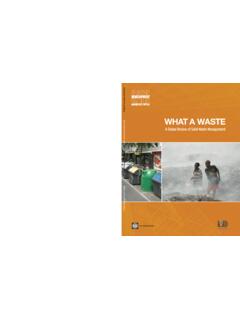Transcription of Structural Geology –Practice Questions and Answers Revised ...
1 Structural Geology Practice Questions and Answers Revised November 2008 . 1. Terms used to describe surfaces across which there has been perceptible displacement are many. However, most geologists would prefer one of the falling terms: (a) joints, (b). fractures, (c) cracks, or (d) faults. What term best describes a surface across which there has been perceptible displacement? 2. Force is a term common to physics. Its classical expression is Force = mass * acceleration. However geologists are more concerned with the intensity of force or more succinctly the stress.
2 Stress is defined as _____ . 3. Stresses produce strains in Earth materials. What are strains? 4. There are two end-member varieties of faults: dip-slip and strike-slip. The displacement along a strike-slip fault is _____ to the strike of the fault. 5. The orientation of a plane in space is expressed by its attitude; a term consisting of two components, strike and dip. Define strike. Define dip. 6. Though many beds are upright others are not. For example, an overturned bed is one that has been rotated more than _____ degrees. 7. A dip-slip fault consists of the dipping fault surface and hanging and footwall blocks.
3 The hanging wall block lies _____ the dipping fault surface. 8. In the following illustration what block is the White Pine located on? What block is the Maple located on? What kind of fault is illustrated? 9. The footwall block lies _____ a dipping fault surface. 10. What do you call a three dimensional surface separating Earth material of differing aspect? 11. In a dip-slip fault, if the hanging wall block moved up relative to the footwall block, then the fault is classified as a _____ . 12. In a dip-slip fault, if the hanging wall block moved down relative to the footwall block, then the fault is classified as a _____.
4 13. In the following illustration what block is the Willow located on? What kind of fault is illustrated? 14. Imagine the following. A road is cut by a vertical dipping fault. As you walk along the road toward the fault, at the intersection of the fault and road, you have to turn to your right and walk some distance along the fault until you encounter the continuation of the road. What would you call the fault? 15. Imagine the following. A set of rail road tracks are cut by a vertical dipping fault. As you walk along the railroad tracks toward the fault, at the intersection of the tracks and the fault, you have to turn to your left and walk about 10 meters along the fault until you encounter the continuation of the railroad tracks.
5 What would you call the fault? 16. In the following block diagram, what kind of fault is illustrated? 17. In the following block diagram, what kind of fault is illustrated? 18. Folds are either anticlines or synclines. Many large hydrocarbon reservoirs occur within the cores of anticlines while adjacent synclines may contain the source of such material. Folds are _____ distortions of rock bodies. 19. Take a piece of paper and bend it into a fold. Now visually locate the locus of all points of maximum curvature on the folded piece of paper. Imagine now that the folded piece of paper is a bed of sandstone, 3 meters thick and extending over a 1 square kilometer area.
6 The locus of all maximum points of curvature on a folded layer is termed the _____. 20. Take a book from your pack or book shelf. Bend the pages into a fold. Now imagine that the pages of your book represent a sequence of sandstones beds separated by mudstones. That is, the first page is a sandstone bed, the second a mudstone bed, the third another sandstone bed, The surface that contains all of the hinge lines in a given fold in a sequence of beds is called the _____. 21. Look closely at the fold that you created in the pages of the book (see previous question).
7 Note the geometrical relationship between the axial surface and the rest of the fold. The limbs of the fold occur on either side of the axial surface. The axial surface _____ the limbs of a fold. 22. Please answer the question shown in the following illustration? 23. Please answer the question shown in the following illustration? 24. Please answer the question shown in the following illustration? 25. In an anticline layers of Earth material converge in what direction? 26. In a syncline layers of Earth material converge in what direction? 27. Please answer the question shown on the following illustration.
8 28. Please answer the question shown on the following illustration. 29. Which of the following is not a stress term? (a) megaPascal, (b) Pascal, (c) kilobars, (d). kilometers 30. Plastic material when stressed beyond a certain critical point called the yield stress flows readily. After unloading ( , removing the imposed stress) a plastic material it will _____. 31. When a stress is applied to an elastic material its response will vary dramatically from that of a plastic material. After unloading ( , removing an applied stress) an elastic material it will _____.
9 32. Structures that closely resemble planes are common features of the crust of planet Earth. Examples include beds, joints, and faults. The attitude of a plane is expressed by its _____ and _____. 33. What kinds of structures are represented by the following geologic map symbols? 34. Please fill in the missing labels for the major faults shown in the following illustration. Answers 1. (d) faults 2. force divided by area 3. distortions or changes in shapes 4. parallel 5. The direction of a line produced by the intersection of a dipping and horizontal plane.
10 Strike is normally given as a direction relative to north. Examples include N20W, N45E, etc. Dip is the angle between an inclined and horizontal plane measured in a plane that is at right angles to strike. 6. 90. 7. above 8. The White Pine is on the footwall block. The Maple is on the hanging wall block. A. normal fault is illustrated. 9. below 10. contact 11. reverse 12. normal 13. The Willow is on the hanging wall block. A reverse fault is illustrated. 14. right-lateral strike-slip fault 15. left-lateral strike-slip fault 16. left-lateral strike-slip fault 17.







